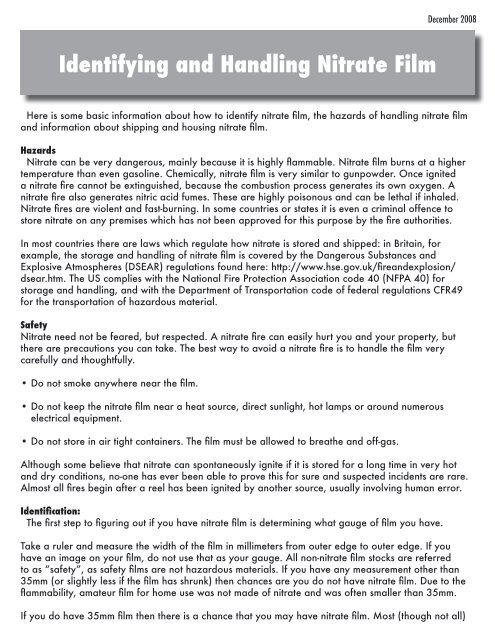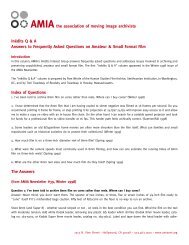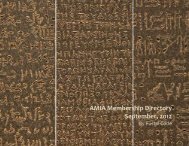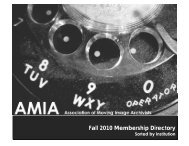Identifying and Handling Nitrate Film - the Association of Moving ...
Identifying and Handling Nitrate Film - the Association of Moving ...
Identifying and Handling Nitrate Film - the Association of Moving ...
You also want an ePaper? Increase the reach of your titles
YUMPU automatically turns print PDFs into web optimized ePapers that Google loves.
<strong>Identifying</strong> <strong>and</strong> H<strong>and</strong>ling <strong>Nitrate</strong> <strong>Film</strong><br />
December 2008<br />
Here is some basic information about how to identify nitrate film, <strong>the</strong> hazards <strong>of</strong> h<strong>and</strong>ling nitrate film<br />
<strong>and</strong> information about shipping <strong>and</strong> housing nitrate film.<br />
Hazards<br />
<strong>Nitrate</strong> can be very dangerous, mainly because it is highly flammable. <strong>Nitrate</strong> film burns at a higher<br />
temperature than even gasoline. Chemically, nitrate film is very similar to gunpowder. Once ignited<br />
a nitrate fire cannot be extinguished, because <strong>the</strong> combustion process generates its own oxygen. A<br />
nitrate fire also generates nitric acid fumes. These are highly poisonous <strong>and</strong> can be lethal if inhaled.<br />
<strong>Nitrate</strong> fires are violent <strong>and</strong> fast-burning. In some countries or states it is even a criminal <strong>of</strong>fence to<br />
store nitrate on any premises which has not been approved for this purpose by <strong>the</strong> fire authorities.<br />
In most countries <strong>the</strong>re are laws which regulate how nitrate is stored <strong>and</strong> shipped: in Britain, for<br />
example, <strong>the</strong> storage <strong>and</strong> h<strong>and</strong>ling <strong>of</strong> nitrate film is covered by <strong>the</strong> Dangerous Substances <strong>and</strong><br />
Explosive Atmospheres (DSEAR) regulations found here: http://www.hse.gov.uk/fire<strong>and</strong>explosion/<br />
dsear.htm. The US complies with <strong>the</strong> National Fire Protection <strong>Association</strong> code 40 (NFPA 40) for<br />
storage <strong>and</strong> h<strong>and</strong>ling, <strong>and</strong> with <strong>the</strong> Department <strong>of</strong> Transportation code <strong>of</strong> federal regulations CFR49<br />
for <strong>the</strong> transportation <strong>of</strong> hazardous material.<br />
Safety<br />
<strong>Nitrate</strong> need not be feared, but respected. A nitrate fire can easily hurt you <strong>and</strong> your property, but<br />
<strong>the</strong>re are precautions you can take. The best way to avoid a nitrate fire is to h<strong>and</strong>le <strong>the</strong> film very<br />
carefully <strong>and</strong> thoughtfully.<br />
• Do not smoke anywhere near <strong>the</strong> film.<br />
• Do not keep <strong>the</strong> nitrate film near a heat source, direct sunlight, hot lamps or around numerous<br />
electrical equipment.<br />
• Do not store in air tight containers. The film must be allowed to brea<strong>the</strong> <strong>and</strong> <strong>of</strong>f-gas.<br />
Although some believe that nitrate can spontaneously ignite if it is stored for a long time in very hot<br />
<strong>and</strong> dry conditions, no-one has ever been able to prove this for sure <strong>and</strong> suspected incidents are rare.<br />
Almost all fires begin after a reel has been ignited by ano<strong>the</strong>r source, usually involving human error.<br />
Identification:<br />
The first step to figuring out if you have nitrate film is determining what gauge <strong>of</strong> film you have.<br />
Take a ruler <strong>and</strong> measure <strong>the</strong> width <strong>of</strong> <strong>the</strong> film in millimeters from outer edge to outer edge. If you<br />
have an image on your film, do not use that as your gauge. All non-nitrate film stocks are referred<br />
to as “safety”, as safety films are not hazardous materials. If you have any measurement o<strong>the</strong>r than<br />
35mm (or slightly less if <strong>the</strong> film has shrunk) <strong>the</strong>n chances are you do not have nitrate film. Due to <strong>the</strong><br />
flammability, amateur film for home use was not made <strong>of</strong> nitrate <strong>and</strong> was <strong>of</strong>ten smaller than 35mm.<br />
If you do have 35mm film <strong>the</strong>n <strong>the</strong>re is a chance that you may have nitrate film. Most (though not all)
<strong>Identifying</strong> <strong>and</strong> H<strong>and</strong>ling <strong>Nitrate</strong> <strong>Film</strong><br />
December 2008<br />
35mm film stock manufactured before 1951 is nitrate. The next step is to determine what year your film<br />
is from. If you do not already know when your film is from <strong>the</strong>n do a basic search on such sites like <strong>the</strong><br />
Internet Movie Database (www.imdb.com). Any film produced in <strong>the</strong> United States after 1950 cannot<br />
be nitrate film. If you have a film that you believe to be made before 1950 <strong>the</strong>n you will need to do<br />
a basic visual inspection <strong>of</strong> <strong>the</strong> reel to determine whe<strong>the</strong>r you have a vintage nitrate print or a safety<br />
copy made after 1950. In Europe, nitrate film was produced through <strong>the</strong> first years <strong>of</strong> <strong>the</strong> 1950s <strong>and</strong><br />
on rare occasions has been found in films from <strong>the</strong> early 1960s. If you have a film you believe to be<br />
from Europe that could fall under <strong>the</strong>se qualifications <strong>and</strong> are uncertain <strong>of</strong> <strong>the</strong> film stock <strong>the</strong>n please<br />
seek out fur<strong>the</strong>r expertise by visiting your<br />
nearest institution.<br />
If you unwind <strong>the</strong> film a few feet <strong>the</strong>n you<br />
should be able to read some information<br />
along <strong>the</strong> edges, beside <strong>the</strong> perforations.<br />
Most film stock made after 1920 was marked<br />
with what type <strong>of</strong> stock it was created from<br />
with <strong>the</strong> words “<strong>Nitrate</strong> <strong>Film</strong>”, “Safety <strong>Film</strong>”<br />
or sometimes just <strong>the</strong> letter “S” which denotes<br />
that <strong>the</strong> stock is safety. If any <strong>of</strong> <strong>the</strong>se phrases<br />
can be read along <strong>the</strong> edges in black writing<br />
<strong>the</strong>n you know what you have. Make sure<br />
that you are reading <strong>the</strong> black writing <strong>and</strong> not<br />
any white writing on black – this would be an<br />
imprint from <strong>the</strong> negative from which it was<br />
made, which is not necessarily <strong>of</strong> <strong>the</strong> same film<br />
stock.<br />
Ano<strong>the</strong>r way <strong>of</strong> identifying <strong>the</strong> year <strong>the</strong> film<br />
was manufactured is by checking edge codes.<br />
These are markings along <strong>the</strong> edges (reading<br />
length wise) that denote when <strong>the</strong> film was<br />
made. Along <strong>the</strong> area where “<strong>Nitrate</strong>” or<br />
“Safety” can be read, if <strong>the</strong> words “Kodak”<br />
or “Eastman” can be read <strong>the</strong>n you can<br />
reference your symbols at this website:<br />
http://www.historicphotoarchive.com/f1/<br />
ekcode.html<br />
If <strong>the</strong>se words or symbols cannot be seen <strong>the</strong>n<br />
<strong>the</strong>re are sometimes “tick” marks that denote<br />
if <strong>the</strong> film is nitrate or safety. Again along <strong>the</strong><br />
edges <strong>of</strong> <strong>the</strong> film (not within <strong>the</strong> picture or <strong>the</strong><br />
frame) if a small black mark runs <strong>the</strong> length <strong>of</strong><br />
<strong>the</strong> film (parallel to <strong>the</strong> edge <strong>and</strong> <strong>the</strong> image)<br />
You can use <strong>the</strong> following simple pointers to establish whe<strong>the</strong>r<br />
a film you have is likely to be nitrate.<br />
* As a general rule your film can only be nitrate if it is 35mm<br />
wide, with perforations along both edges <strong>and</strong> was manufactured<br />
before 1951.<br />
* The word ‘nitrate’ printed between one row <strong>of</strong> perforations<br />
<strong>and</strong> <strong>the</strong> edge <strong>of</strong> <strong>the</strong> film indicates that your film is likely to be<br />
nitrate, but if it was made between 1948 <strong>and</strong> <strong>the</strong> mid-50s <strong>the</strong><br />
marking does not establish that beyond doubt <strong>and</strong> you will<br />
need to fur<strong>the</strong>r inspect <strong>the</strong> film.<br />
* The word ‘safety’ printed between one row <strong>of</strong> perforations<br />
<strong>and</strong> <strong>the</strong> edge <strong>of</strong> <strong>the</strong> film indicates that your film is likely to be<br />
safety film, but if it was made between 1948 <strong>and</strong> <strong>the</strong> mid-50s<br />
<strong>the</strong> marking again does not establish that beyond doubt.<br />
* If your film is 16mm wide (which can have perforations on<br />
both sides or just one), it is almost certainly not nitrate. Small<br />
quantities <strong>of</strong> 16mm nitrate are believed to have been made in<br />
<strong>the</strong> Soviet Union <strong>and</strong> China in <strong>the</strong> ‘50s <strong>and</strong> ‘60s, but none is<br />
known to have been exported to <strong>the</strong> west.<br />
* If your film is 8mm wide (perforations on one side only) or<br />
9.5mm (perforations in <strong>the</strong> center, between each frame)<br />
wide, it is not nitrate.<br />
* If your film smells <strong>of</strong> vinegar it is not nitrate.<br />
* If your film smell like mothballs or camphor <strong>the</strong>n <strong>the</strong>re is a<br />
small chance it could be made <strong>of</strong> nitrate <strong>and</strong> fur<strong>the</strong>r inspection<br />
will have to be done.<br />
* If your film shows signs <strong>of</strong> bubbling, a honey-like goo, or a<br />
fine rust-colored powder, you probably have nitrate that is in<br />
an advanced stage <strong>of</strong> deterioration.<br />
* If a film has no markings <strong>the</strong>n you should assume that it<br />
is nitrate.
<strong>Identifying</strong> <strong>and</strong> H<strong>and</strong>ling <strong>Nitrate</strong> <strong>Film</strong><br />
December 2008<br />
<strong>the</strong>n <strong>the</strong> film is safety. If any tick marks run towards <strong>the</strong> image area width wise <strong>the</strong>n <strong>the</strong>se denote that<br />
<strong>the</strong> film is nitrate.<br />
There are a few exceptions that do not follow <strong>the</strong>se general rules. One <strong>of</strong> which are <strong>the</strong> negatives <strong>of</strong><br />
“Movette” film which are 17mm but happen to be on nitrate stock. While <strong>the</strong>re are o<strong>the</strong>r ways to tell<br />
if your film is nitrate or safety, <strong>the</strong>y tend to be subjective <strong>and</strong> <strong>the</strong>refore are not always accurate. If in<br />
doubt, always assume you are dealing with nitrate film <strong>and</strong> contact an archive who can assist you in<br />
identifying your film.<br />
Shipping:<br />
If you believe an item to be nitrate <strong>the</strong>n it cannot be shipped by a st<strong>and</strong>ard postal or courier service.<br />
A certified courier with <strong>the</strong> relevant skills, training <strong>and</strong> equipment to ship flammable solids is required,<br />
such as FedEx or PackAir. Before <strong>the</strong>y accept shipment, you should tell <strong>the</strong>m that this item is (or could<br />
be) UN materials classification no. 1324, category 4.1 (flammable solids). Expect that shipping will<br />
cost more than usual. <strong>Nitrate</strong> must never, under any circumstances, be carried as passenger baggage<br />
(ei<strong>the</strong>r cabin baggage or checked) by commercial air carriers <strong>and</strong> caution must be used when transporting<br />
nitrate in a vehicle.<br />
If you have nitrate <strong>and</strong> are looking for a facility that is able to ei<strong>the</strong>r verify for you that it is nitrate or<br />
for a facility that will accept your film as a donation (few places will take nitrate as a deposit) <strong>the</strong>n feel<br />
free to contact any <strong>of</strong> <strong>the</strong> labs or archives below:<br />
Jim Hahn – <strong>Nitrate</strong> <strong>Film</strong> Curator<br />
Academy <strong>of</strong> Motion Picture Arts <strong>and</strong> Sciences Archive<br />
1313 North Vine Street • Hollywood, CA 90028<br />
Ph: (310) 247-3000 x.383<br />
jhahn@oscars.org<br />
Todd Wiener – Motion Picture Archivist<br />
UCLA <strong>Film</strong> & Television Archive<br />
1015 North Cahuenga Blvd. • Los Angeles, CA 90038-2616<br />
Ph: (323)462-4921 x40 • Fx: (323)469-9055 • twiener@ucla.edu • www.cinema.ucla.edu<br />
Deborah Stoiber – <strong>Nitrate</strong> Vault Manager<br />
George Eastman House - Louis B. Mayer Conservation Center<br />
900 East Ave • Rochester, NY 14607<br />
Ph: (585)889-8140 or (595) 271-3361• dstoiber@geh.org<br />
George Willeman – <strong>Nitrate</strong> Vault Manager<br />
Library <strong>of</strong> Congress – National Audio-Visual Conservation Center<br />
19053 Mt. Pony Rd. • Culpeper, VA 22701<br />
Ph: (202)707-0150 • gwil@loc.gov.
<strong>Identifying</strong> <strong>and</strong> H<strong>and</strong>ling <strong>Nitrate</strong> <strong>Film</strong><br />
December 2008<br />
Arthur Wehrhahn – Manager<br />
The Museum <strong>of</strong> Modern Art – Celeste Bartos Preservation Center<br />
Sawmill Road • Salem Route 367 • Hamlin, PA 18427<br />
Ph: (570)689-2226 • arthur_wehrhahn@moma.org<br />
NOTE: The <strong>Film</strong> Preservation Center would consider accepting donations into <strong>the</strong>ir permanent collection<br />
<strong>and</strong> are willing to assist in identifying nitrate material.<br />
Liz C<strong>of</strong>fey – HFA <strong>Film</strong> Conservator<br />
Harvard <strong>Film</strong> Archive<br />
24 Quincy Street • Cambridge, MA 02138<br />
Ph: (617)496-8647 • c<strong>of</strong>fey@fas.harvard.edu<br />
http://hcl.harvard.edu/hfa/<br />
Robert David – CEO<br />
The CinemaLab<br />
2735 South Raritan Street • Englewood, Colorado 80110<br />
Ph: (303)783-1020 • Fx: (303) 806-0555 fax •Robert@<strong>the</strong>CinemaLab.com<br />
Meg Labrum – Chief Curator<br />
National <strong>Film</strong> <strong>and</strong> Sound Archive<br />
McCoy Circuit • Acton, ACT 2601 • Australia<br />
Ph: +61-2-6248-8104 • meg.labrum@nfsa.gov.au<br />
www.nfsa.gov.au (new web address, effective July 1st, 2008)<br />
Note: Donations <strong>of</strong> nitrate film are accepted only after consultation with our curatorial staff. No<br />
temporary storage unless agreed upon with curatorial staff.<br />
Ca<strong>the</strong>rine Cormon – <strong>Film</strong> Collections<br />
Nederl<strong>and</strong>s <strong>Film</strong>museum<br />
Postbus 74782 • 1070 BT Amsterdam • The Ne<strong>the</strong>rl<strong>and</strong>s<br />
Ph: +31 20 58 91 400 • Fx: + 31 20 68 33 401 • ccormon@filmmuseum.nl<br />
For donations <strong>of</strong> nitrate contact:<br />
Ms Leontien Bout • Legal Dept.<br />
lbout@filmmuseum.nl<br />
Note: Languages: Dutch, English, French, German, Italian, Spanish<br />
Accepts only donations <strong>of</strong> materials that fit <strong>the</strong> collection policy, <strong>and</strong> will re-direct o<strong>the</strong>r materials to<br />
a better-suited institution. Can <strong>of</strong>fer technical support to potential donors to help <strong>the</strong>m determine if<br />
<strong>the</strong>ir material will be suitable for us, should <strong>the</strong>y not know what it is
<strong>Identifying</strong> <strong>and</strong> H<strong>and</strong>ling <strong>Nitrate</strong> <strong>Film</strong><br />
December 2008<br />
Kas<strong>and</strong>ra O’Connell – Head <strong>of</strong> Irish <strong>Film</strong> Archive<br />
Irish <strong>Film</strong> Institute<br />
6 Eustace Street • Temple Bar,Dublin 2.<br />
Ph:+353 1 6795744 • Fx: +353 1 677 8755 • koconnell@irishfilm.ie<br />
www.irishfilm.ie<br />
Note: The Irish <strong>Film</strong> Institute is unable to keep nitrate film over night but <strong>the</strong>y can identify it <strong>and</strong> will<br />
consider accepting nitrate film if contacted in advance.<br />
Deborah Steinmetz – Director <strong>and</strong> Client Services Librarian<br />
Steven Spielberg Jewish <strong>Film</strong> Archive<br />
Jerusalem • 91905 • Israel.<br />
Ph: 972-2-5881511 • Fx: 972-2-5812061<br />
http://www.spielbergfilmarchive.org.il<br />
Note: Can only temporarily store a film<br />
Dick Millais – Vice Present Marketing<br />
IVC Digital <strong>Film</strong> Center<br />
2777 North Ontario Street • Burbank, CA 01504<br />
Ph: (818)569-4949 - Fax: 818-569-4949 - dmillais@ivchd.com<br />
Note: IVC is one <strong>of</strong> <strong>the</strong> only places that transfers nitrate to data formats.<br />
Greg Wilsbacher – Director <strong>and</strong> Curator<br />
Newsfilm Library – University <strong>of</strong> South Carolina<br />
Columbia, SC 29208<br />
Ph: (803)777-6841 - (803) 777-4756 [fax] - gregw@sc.edu<br />
The British <strong>Film</strong> Institute:<br />
The best way for <strong>the</strong> public to contact The BFI National Archive with any queries is to go to www.<br />
bfi.org.uk <strong>the</strong>n click on Contact Us <strong>the</strong>re is a drop-down menu for National Archive Enquiries. These<br />
enquires are regularly read by experienced BFI staff <strong>and</strong> forwarded to <strong>the</strong> best person, so it really is<br />
<strong>the</strong> best way to ensure that <strong>the</strong> right people are contacted.<br />
NOTE: Abbott’s Data Store is <strong>the</strong> only commercial organization in <strong>the</strong> United Kingdom which stores<br />
nitrate film. http://www.abbotgroup.co.uk/<br />
Also available to citizens in <strong>the</strong> United Kingdom are <strong>the</strong> archives found at <strong>the</strong> <strong>Film</strong> Archive Forum:<br />
www.bufvc.uk/faf Check <strong>the</strong>ir list <strong>of</strong> archives to contact <strong>the</strong> institution nearest to you.<br />
If you have any questions feel free to contact <strong>the</strong> co-chairs <strong>of</strong> AMIA’s <strong>Nitrate</strong> <strong>Film</strong> Interest Group at<br />
rparker@oscars.org, jessijones@oscars.org, or mlevesque@oscars.org






